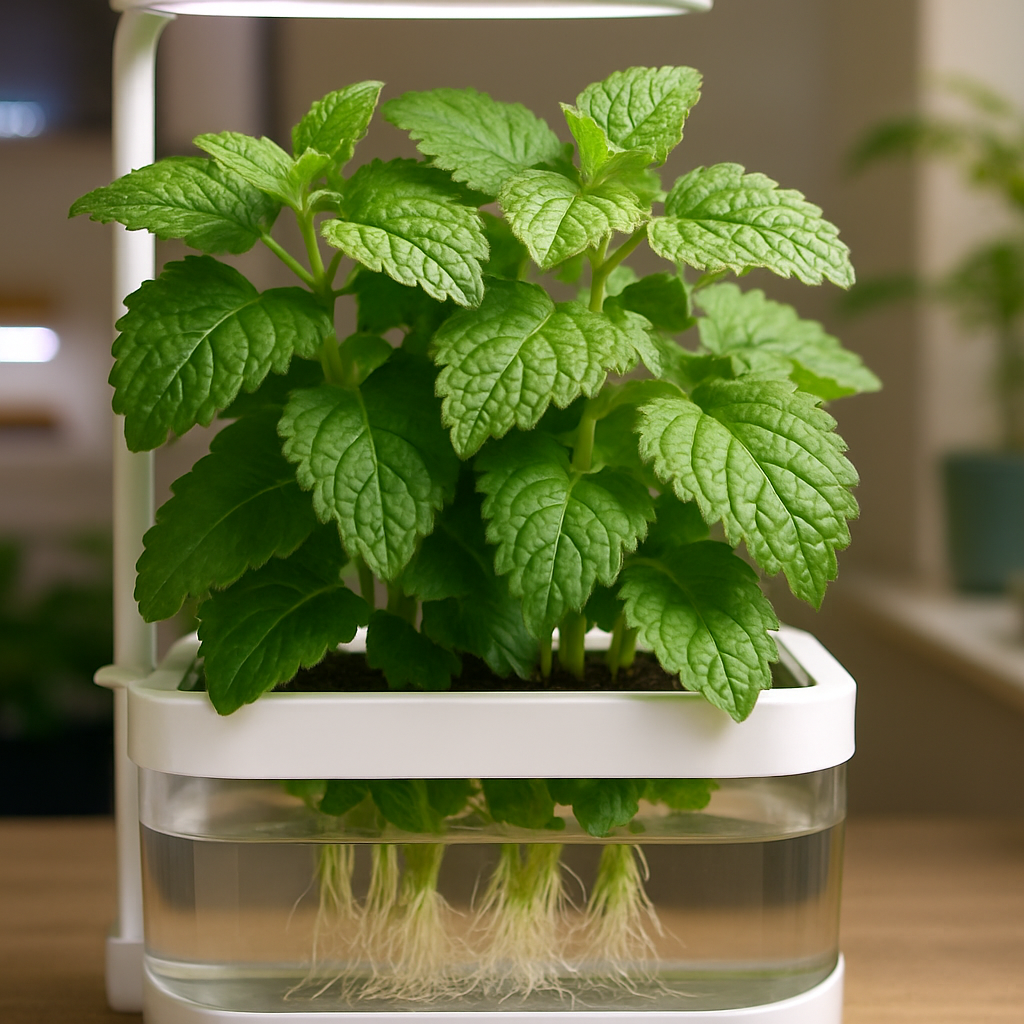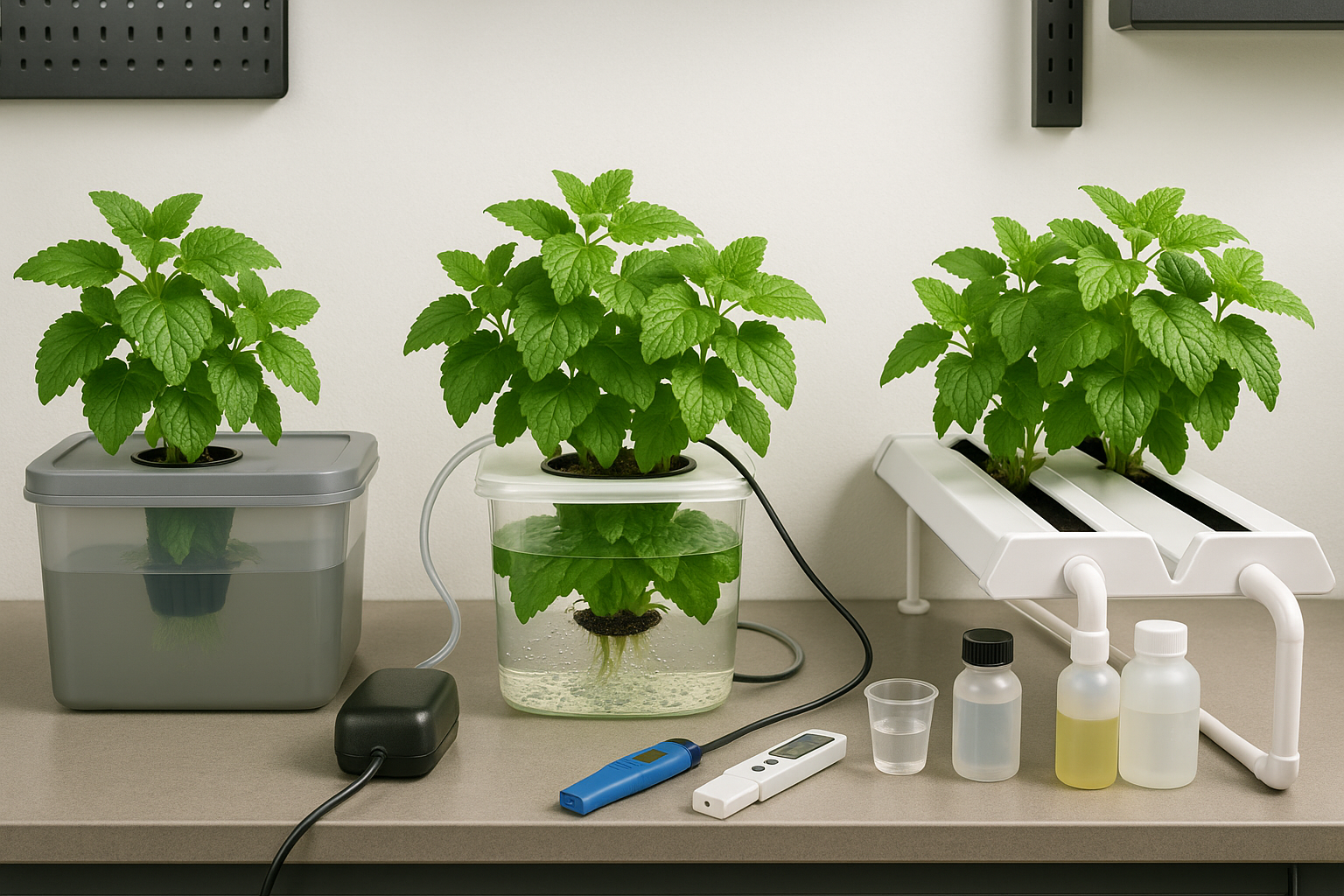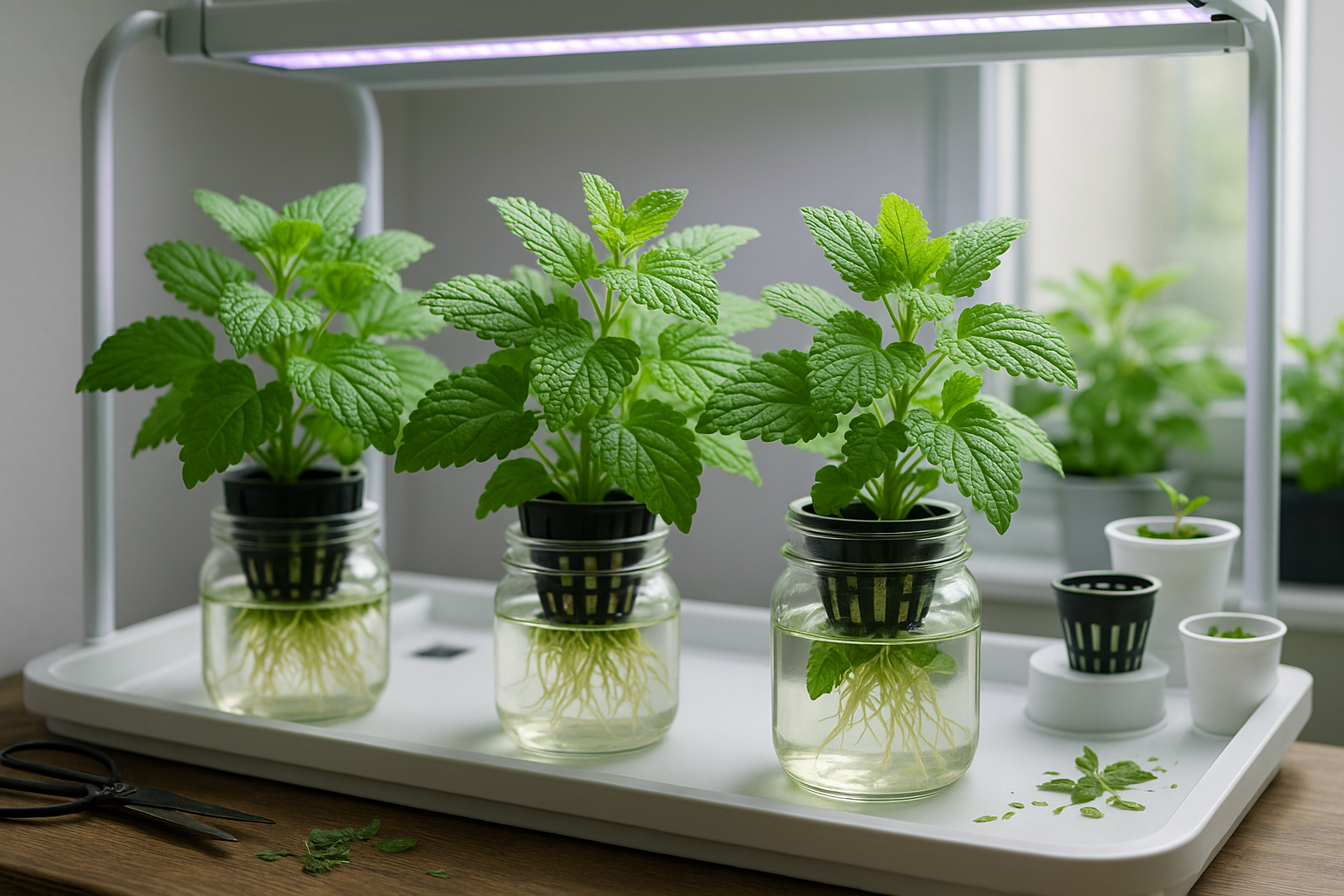Introduction
If you’re curious about growing herbs indoors, you’ve probably wondered if hydroponic lemon balm can thrive without soil. Lemon balm (Melissa officinalis) is a popular member of the mint family, prized for its citrusy scent, soothing properties, and culinary versatility. Hydroponic growing—cultivating plants in water and nutrient-rich solutions instead of soil—is an increasingly popular method for gardeners aiming for faster growth and greater control over their plants’ environment.
The good news is: yes, lemon balm can absolutely be grown hydroponically—and many gardeners are catching on to the benefits.
Why Choose Hydroponic Lemon Balm?
What makes hydroponic lemon balm so appealing? For starters:
- You can precisely regulate nutrients and water, helping your plants grow faster with fewer pests and diseases.
- You aren’t limited by seasons or outdoor weather, allowing for a fresh, lush harvest of lemon balm year-round—perfect for teas, natural remedies, and more.
In this article, we’ll break down how hydroponic systems work, why lemon balm is a great candidate, tips for setting up your own indoor garden, and potential challenges to watch for as you cultivate your own thriving supply of lemon balm without soil.
Why Grow Lemon Balm Hydroponically?

Growing lemon balm hydroponically is a game-changer for both home gardeners and small-scale commercial growers who want fresh herbs without the limitations of soil. One standout benefit is year-round production. Indoors, you’re not hostage to unpredictable weather or short growing seasons—lemon balm thrives consistently under grow lights or in sunny windows.
Hydroponics speeds up growth, too, meaning you can expect to start your first harvest just weeks after planting, rather than waiting months as you would in outdoor soil. The result? A steady supply of lush, fragrant leaves whenever you need them for teas, garnishes, or even natural remedies—a valuable perk given lemon balm’s popularity in calming teas, homemade balms, and culinary recipes.
Hydroponic systems keep your herbs much cleaner, reducing the need for extensive washing and making them ready to use straight from the planter. They also make the most of your space, letting you grow lemon balm vertically on shelves or in compact units, which is perfect for apartments, balconies, or tight garden corners where traditional beds aren’t an option.
Compared to soil-based gardening, hydroponics avoids many issues like pests, weeds, and inconsistent watering, which often stunt or damage delicate lemon balm plants. However, it’s not entirely without challenges—maintaining the right nutrient balance and pH can take some trial and error, and beginners might need to invest a bit of time learning system basics.
But as many urban gardeners discover, the cleaner harvests, faster growth cycle, and space-saving designs quickly outweigh the initial learning curve. For anyone who loves adding fresh lemon balm to recipes, teas, or homemade self-care products, hydroponics makes this rewarding herb accessible throughout the year, rain or shine.
Choosing Your Hydroponic System

When growing lemon balm hydroponically, you have a few main systems to consider: Kratky, Nutrient Film Technique (NFT), and Deep Water Culture (DWC). Each setup offers unique advantages and some trade-offs.
The Kratky method is the simplest and most beginner-friendly. It requires only a container, a net pot, and nutrient-rich water—no pumps or electricity needed. This passive system works well for small batches of herbs like lemon balm and is ideal if you’re short on space or want a low-maintenance option. However, Kratky’s limited oxygenation might restrict growth if you’re aiming for larger harvests.
If you’re ready to invest a bit more time and effort, DWC is another great option. In this system, plant roots sit in a well-oxygenated reservoir of nutrient solution, usually kept bubbling by an aquarium pump and an airstone. DWC delivers consistently larger, lusher lemon balm thanks to steady access to nutrients and oxygen, but it requires monitoring water temperature and pH regularly.
For those looking to scale up or grow several plants at once, NFT systems shine. Here, a thin film of nutrient solution runs continuously over the roots inside sloped channels. NFT is space-efficient and supports rapid, vigorous growth, but it’s more complex—good water flow and backup power are essential to avoid drying out the roots.
For all these systems, be sure to:
- Choose clean, food-safe containers
- Keep your setup in a well-ventilated spot with indirect sunlight or quality grow lights
- Allow enough space for plants to spread
Starting small with Kratky or DWC lets you master the basics before graduating to bigger, more complex NFT setups. This way, you can tailor your approach based on your yield goals and available space.
How to Start Lemon Balm from Seeds or Transplants
Starting lemon balm in a hydroponic system can be done either from seeds or by transplanting young plants, with each method offering its own advantages. Growing lemon balm from seed is cost-effective and lets you cultivate a large number of plants, but germination can be slow and a bit finicky.
For best results, sow lemon balm seeds on the surface of moist, sterile starting mix—they need light to germinate, so don’t cover them with soil. Aim for a temperature between 65-70°F (18-21°C), and use a humidity dome or plastic wrap to keep moisture in until seedlings appear, which usually takes 10-21 days.
If you’re looking for speed or predictability, purchasing young transplants from a nursery is a great shortcut. Gently rinse soil-grown plants under lukewarm water to remove all soil before transferring them into your hydroponic media, such as rockwool or clay pellets. This helps prevent disease and pests from entering your system.
When spacing your lemon balm in the hydroponic unit, leave about 8-10 inches between plants. This gives the roots and foliage enough room to develop without crowding, which supports airflow and reduces the risk of mildew.
Keep the nutrient solution mild at first (about a quarter to half strength) until the plants are established, and ensure the roots always stay moist but never waterlogged. During the early weeks, monitor for signs of transplant shock, like drooping leaves, and provide plenty of gentle light—ideally, 14-16 hours a day under grow lights.
With close attention to these details, you’ll set your lemon balm up for healthy and vigorous hydroponic growth, whether you start from scratch or give young plants a fresh start.
Setting Up Ideal Conditions for Hydroponic Lemon Balm
Creating the perfect environment for hydroponic lemon balm starts with water quality—use clean, filtered water to prevent mineral buildup or contaminants that could harm your plants. Aim for a pH range between 5.5 and 6.5, which allows lemon balm roots to absorb key nutrients efficiently. Consistently check pH levels using a digital meter, adjusting with pH up or down solutions as needed.
For nutrient balance, select a quality hydroponic solution with balanced NPK values—ideally around 3-1-5 or 2-1-4—and ensure it includes essential micronutrients like calcium, magnesium, and iron. Both insufficient and excessive nutrients can cause yellowing leaves or stunted growth, so follow manufacturer guidelines and keep an eye on your plants’ health regularly.
When it comes to lighting, full-spectrum LED grow lights are energy-efficient and mimic natural sunlight well. Position the lights about 12–18 inches above your lemon balm and provide 14–16 hours of light daily for optimal growth. Using timers makes maintaining this cycle easy.
Maintain temperatures between 65 and 75°F (18–24°C), as lemon balm thrives in mild climates. Temperatures outside this range can slow growth or stress the plants. Keep humidity moderate—around 40–60%—to avoid excessive leaf moisture, which can invite disease, or dryness, which stresses the plants. A hygrometer and a small fan can help regulate your growing environment effectively.
Over time, track changes by keeping a simple log of adjustments and plant responses to fine-tune your setup. Regularly check water levels, lighting, and climate to ensure conditions stay within these guidelines—this will encourage robust, fragrant lemon balm with every harvest.
Maintaining, Harvesting, and Troubleshooting
Keeping your hydroponic system running smoothly means staying on top of a few vital tasks. Regularly check and refresh your nutrient solution—ideally weekly—to keep it balanced and prevent a buildup of salts that can harm your plants.
Take time every few days to inspect roots for signs of browning or a slimy texture, which can indicate root rot; healthy roots should be white and crisp. Every two to four weeks, pause the system for a thorough cleaning: scrub all containers, pumps, and tubing with a mild peroxide solution to deter algae and bacteria growth.
When it comes to plant care, prune regularly by removing yellowing or crowded leaves to boost airflow and reduce disease risk. Time your harvest for optimal flavor—herbs tend to taste best just before they flower, while leafy greens are sweetest when picked young and tender.
If you notice yellow leaves, test your nutrient pH and adjust for the plant type. Imbalanced pH or a lack of specific nutrients like nitrogen is a frequent culprit. For root rot, reduce watering, increase aeration, and treat with a beneficial microbe solution.
Pests such as aphids or spider mites can invade even clean systems, so inspect stems and leaves often. If you spot trouble, try a gentle insecticidal soap or introduce ladybugs as natural predators.
To boost yield and flavor, maintain consistent lighting, keep temperatures in the ideal range for your crop (usually 65–75°F), and consider supplementing with natural minerals like magnesium or calcium. Finally, rotate crops and stagger plantings to keep your system productive and enjoy a continuous harvest of vibrant, tasty produce.
Conclusion & Top Tips
Hydroponic lemon balm cultivation is a rewarding way to enjoy fresh, fragrant herbs year-round—no garden bed required. With hydroponics, you control nutrients, water, and light, making it easier to avoid pests and boost plant health. This method can save space and speed up growth, making it perfect for both beginners and seasoned gardeners.
If you’re just starting, remember to use clean, filtered water and maintain steady light—at least 12–14 hours per day with a grow light is ideal. Keep an eye on nutrient levels; lemon balm loves a balanced feed, so don’t skip regular checks. Finally, harvest leaves regularly to encourage bushier growth and a steady supply.
Whether you’re growing on your kitchen counter or experimenting with a larger setup, hydroponic lemon balm is fun and adaptable. Have you tried this at home, or do you have questions about setting up your system? Share your experiences or ask below—your insights help everyone grow better!
